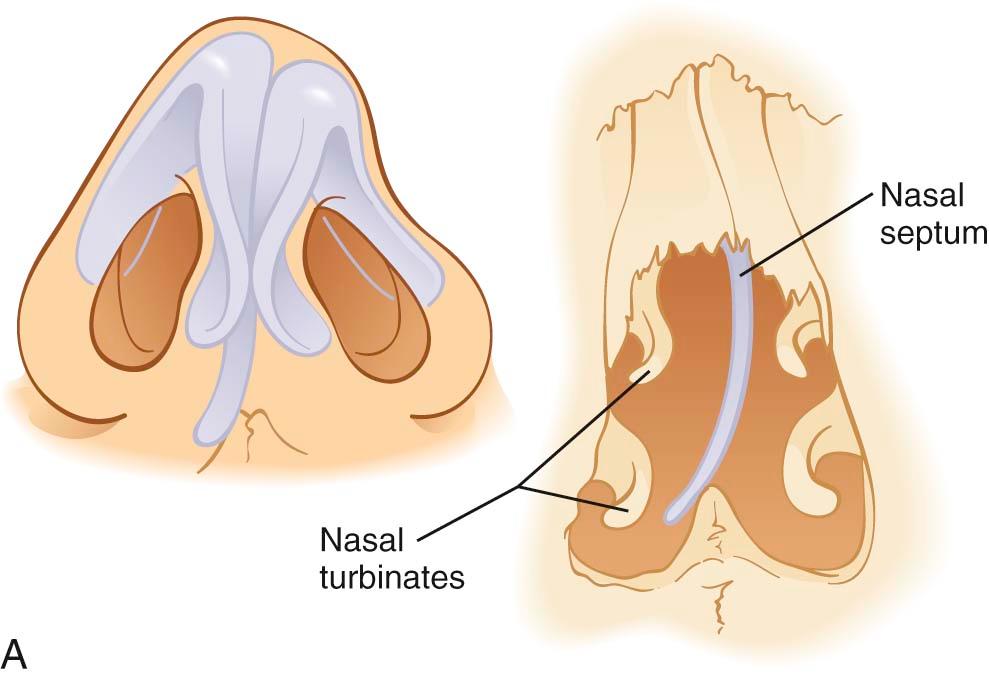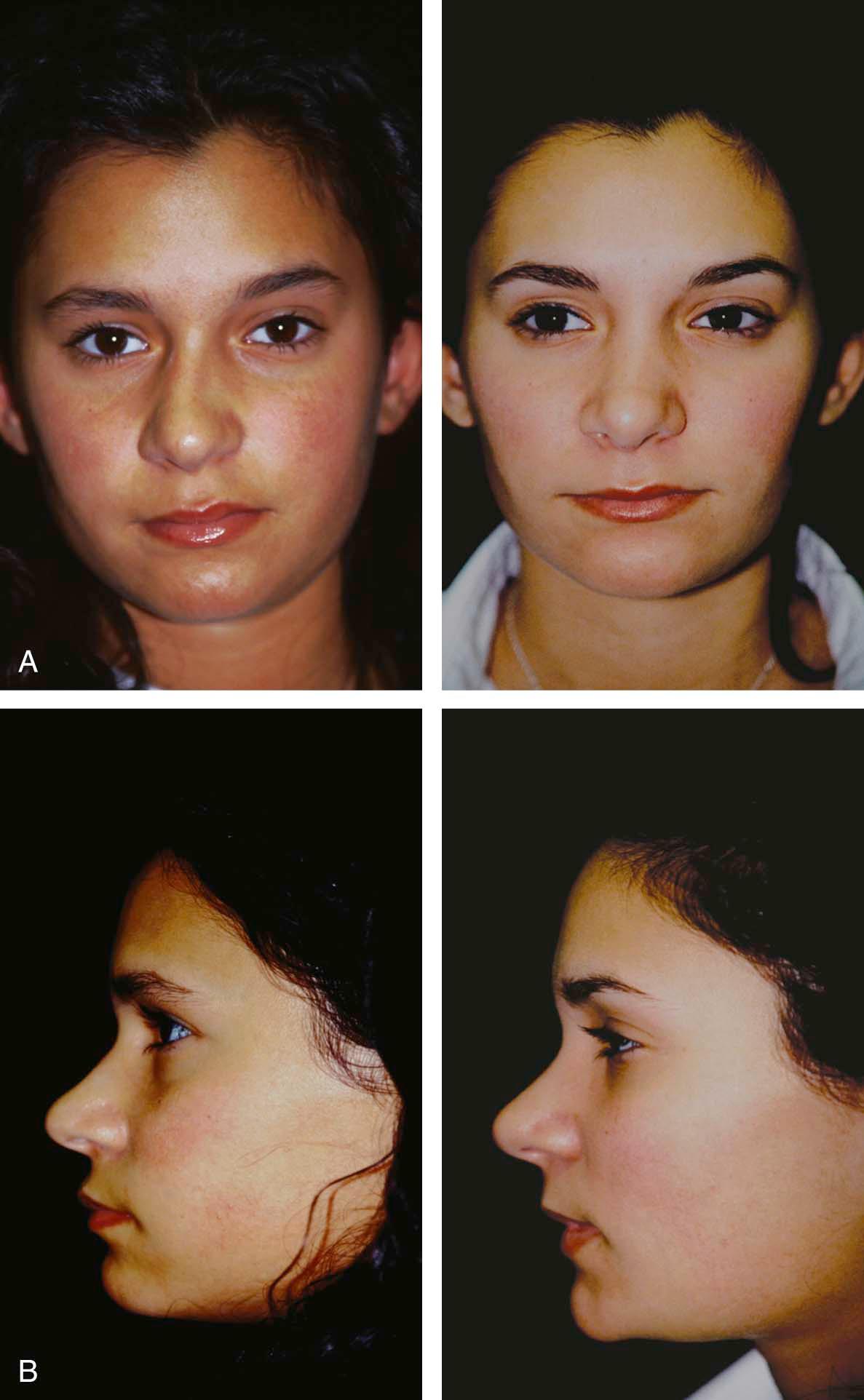Physical Address
304 North Cardinal St.
Dorchester Center, MA 02124
The crooked nose is neither a single entity nor a specific description. Crooked noses represent a spectrum of nasal deformities, most commonly of traumatic origin, that are associated with a deviated or irregular appearance to the nose. For the casual onlooker, the crooked nose may be unsettling because of its disharmony with the rest of the face, much like a picture frame that sits askew on a wall. In common usage, “crooked” connotes not only a lack of straightness but also traits of dishonesty or unsavory character, as contrasted to the forthright person who is “playing it straight.” The term “crooked nose” is thus apt because it not only captures the distinctive external appearance of a misaligned, deviated nose but also suggests the potential for social stigmatization. The surgeon should thus be attentive to not only the anatomic characteristics of the crooked nose but also the potential effects of this deformity on the patient's self-image.
Correction of the crooked nose remains a notoriously difficult challenge for the rhinoplasty surgeon. The complex interplay of functional and aesthetic considerations is coupled with the predilection of this deformity for gradual recurrence, often despite initially successful surgical treatment. The contracture forces of scar formation combined with cartilage thickening and deformation may resist definitive correction. Cartilage's elastic memory, the progressive formation of adhesions, and the collapse of a weakened septum are all contributory factors. An understanding of the relevant anatomy and pathogenesis of the deformity informs the surgical approach. This chapter covers the etiology, analysis, and surgical correction of the crooked nose.
The anatomy of the crooked nose is best understood relative to the constituent components of the osseocartilaginous framework. The upper third of the nose comprises the bony pyramid with its paired nasal bones and ascending processes of the maxillae. Bone thickness tapers along the nasal bones’ caudal aspect. The lower two thirds of the nose are cartilaginous, including the nasal septum, the paired upper lateral cartilages, and the alar cartilages. The cartilage of the septum is relatively wide along the floor of the nose, flattens in the midportion, and is thickest near the dorsum, adjacent to the takeoff of the upper lateral cartilages.
Crooked noses exhibit greater diversity in their patterns of deformity than do isolated bony fractures. This heterogeneity is a reflection of the ability of cartilage to not only fracture but also twist, bend, and remodel in response to injury. The nasal septum behaves much like the rudder of a boat that both acutely and chronically guides the direction of the external nose, lending credence to the surgical maxim, “Where the septum goes, so goes the nose.” Traumatic injury may cause angulation, telescoping, stepoffs, flattening, or splaying of the framework of the nose. The entire nasal pyramid may be deviated to one side, or a canted bony pyramid may be at an angle with the mid vault or lower third of the nose.
The common patterns of crooked or deviated noses are the C-, S-, and I-type deformities shown in Figure 22-1 . The C-shaped deformity usually begins cephalad at the nasal dorsum, proceeds posteroinferiorly through the perpendicular plate of the ethmoid, and then extends into the cartilaginous septum. The S-shaped deformity is characterized by a serpentine twisting of the external nose, usually with corresponding septal deviation. The I-shaped deformity corresponds to a deviation of the entire nasal pyramid. The nose is considered truly deviated if it departs from the midline position, with or without curvature. These deformities are associated with varying degrees of nasal obstruction.

Not all crooked noses fit neatly into this classification scheme. Prior rhinoplasty, pathologic disease processes, and saddling may all produce unpredictable patterns of asymmetry. Some noses that appear crooked do not have a true deviation. For example, when a laterally directed force causes unilateral collapse of a nasal bone, the resulting concavity makes the nose appear deviated to the opposite side. Unilateral infracture of the bony pyramid side wall is often not associated with displacement of the septum. This infracture injury has a more favorable long-term prognosis with surgery and requires less extensive reconstruction than does a true deviation.
The nasal bones are the most commonly fractured bones in the face, and nasal injury is the most common cause of the crooked nose. True deviation is indicative of a high energy injury and requires greater force than an isolated nasal bone depression or fracture. Usually a significant frontal vector is required for deviation to occur. With trauma, the nasal septum is often fractured or displaced from the maxillary crest. Because the nasal framework becomes more ossified and brittle with age, younger patients tend to have larger fracture segments than older patients, who are more prone to nasal bone comminution. As a general rule, nasal trauma associated with septal fracture requires extensive reconstruction and is unlikely to be adequately treated with closed reduction. The surgeon should also consider psychological repercussions of the incident; such factors may influence the patient's readiness to undergo an elective surgical intervention.
The crooked nose deformity may reflect either the acute outcome of a traumatic episode or a remote injury that has been compounded by years of scarring and soft tissue contracture. The cartilaginous septum is the primary shock absorber of the nose, with lesser contributions from the upper lateral cartilages, alar cartilages, and bony components. Patients with untreated or inadequately reduced nasal fractures may develop a crooked nose gradually, with surface irregularities and asymmetries becoming more conspicuous with the passage of years. Cartilage has a low metabolic rate and frequently heals with scar formation. In cases of remote trauma, the patients may recount a worsening of the deformity with time, often associated with progressive nasal airway obstruction due to disruption of nasal support mechanisms. Repetitive fractures may cause profound structural deficiency, and comminution often will induce aberrant growth.
Many patients with a crooked nose do not remember the inciting traumatic injury. The patient with a severely twisted nose and without history of antecedent trauma is likely to have sustained a childhood injury that was overlooked. Relatively minor cartilage trauma may lead to dramatic deformation over time with chondrocyte growth. The pediatric nose lacks a well-developed bridge and is capable of absorbing substantial energy without showing irregularity until later in life. Children's noses are mostly cartilaginous and are susceptible to injuries that produce progressive deformation over subsequent years of growth. In some cases, septal subluxation or fracture may have occurred during birth. Forceps delivery and breach delivery are risk factors, although the head is also subjected to powerful compressive forces during normal passage through the birth canal. Such early deformities may first become evident during adolescence, as shown in Figure 22-2 .

Prior nasal surgery is an important cause of the crooked nose. Asymmetric or incomplete osteotomies often result in deviation and step-off deformities of the upper third of the nose. With green-stick fractures, the bony vault may be subject to residual memory and deviating forces from scarring. Alternatively, if adequate osteotomies are performed but the underlying septal deformity is not addressed, the nasal pyramid will often regress to its original, deviated position. Removal of a dorsal hump in the nose with a straight dorsum and a caudal deviation may unmask an underlying deformity that was not previously visible. Closed reduction of a nasal fracture may result in persistence or creation of a crooked nose if the fracture is not adequately reduced.
Reduction rhinoplasty deserves special consideration due to its potential for creating severe asymmetries that usually become apparent years after surgery. Resection of the nasal osseocartilaginous framework disrupts nasal support mechanisms, often with insidious destabilizing effects. Over the course of years, the contractile forces of scar formation, gravity, and aging conspire to warp and collapse the attenuated nasal scaffold. Such distortions may require major reconstruction years later to address progressive disfigurement and impairment of nasal function. Most rhinoplasty techniques have effects in adjacent zones of the nose during healing. Thus, unexpected deviations often occur from manipulations elsewhere, for example mid vault narrowing and upper lateral cartilage collapse occurring after dorsal hump reduction.
Several relatively rare pathologic processes may lead to a crooked nose. The surgeon should inquire about symptoms of nasal obstruction and history of epistaxis, allergy, and systemic disease. Autoimmune or immunologically mediated diseases may cause resorption of bony or cartilaginous nasal structures. Granulomatous disease, such as Wegener's granulomatosis or sarcoidosis, and collagen vascular/connective tissue disorders are important diagnostic considerations, particularly in patients with nasal septal perforation or saddling. A history of inhalant abuse, such as cocaine, oxymetazoline, nasal steroids, or NeoSynephrine use, should be considered in cases of mucosal atrophy, ulceration, or nasal perforation. The surgeon should also be alert to infectious etiologies such as tuberculosis, syphilis, and HIV infection. Sinonasal polyposis or neoplastic disease may also induce remodeling and/or splaying of nasal framework.
Become a Clinical Tree membership for Full access and enjoy Unlimited articles
If you are a member. Log in here